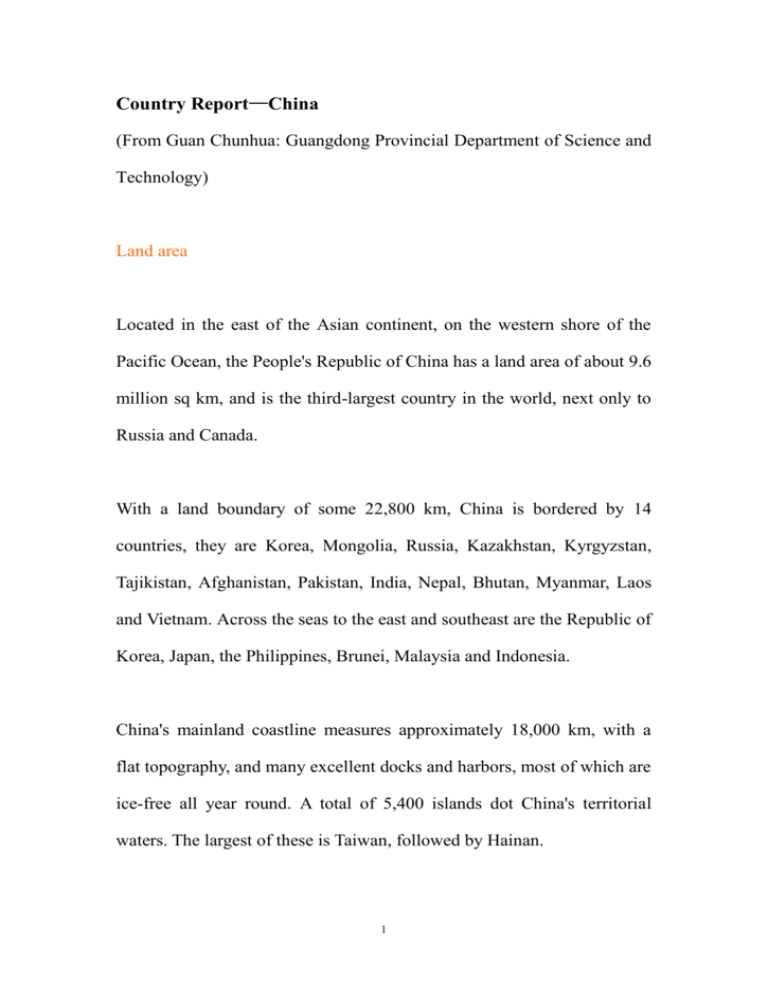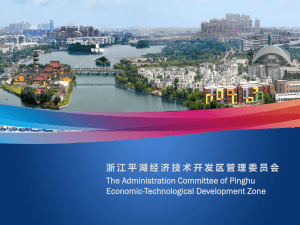Country Report—China
advertisement

Country Report—China (From Guan Chunhua: Guangdong Provincial Department of Science and Technology) Land area Located in the east of the Asian continent, on the western shore of the Pacific Ocean, the People's Republic of China has a land area of about 9.6 million sq km, and is the third-largest country in the world, next only to Russia and Canada. With a land boundary of some 22,800 km, China is bordered by 14 countries, they are Korea, Mongolia, Russia, Kazakhstan, Kyrgyzstan, Tajikistan, Afghanistan, Pakistan, India, Nepal, Bhutan, Myanmar, Laos and Vietnam. Across the seas to the east and southeast are the Republic of Korea, Japan, the Philippines, Brunei, Malaysia and Indonesia. China's mainland coastline measures approximately 18,000 km, with a flat topography, and many excellent docks and harbors, most of which are ice-free all year round. A total of 5,400 islands dot China's territorial waters. The largest of these is Taiwan, followed by Hainan. 1 Topography The topography varies greatly in China, a vast land of lofty plateau, large plains, rolling land and big and small basins surrounded by lofty mountains. Taking a bird's-eye view of China, the terrain gradually descends from west to east like a staircase. Due to the collision of the Indian and Eurasian plates, the Qinghai-Tibet Plateau rose continuously to become the top of the four-step "staircase," averaging more than 4,000 m above sea level, and called "the roof of the world." Soaring 8,848 m above sea level on the plateau is Mount Qomolangma (Mount Everest), the world's highest peak and the main peak of the Himalayas. Mountainous land and very rough terrains make up 2/3 of Chinese territory, and this has created some problems in transport and in the development of agricultural production. However such topographical features are conducive to the development of forestry, mineral and hydropower resources and tourism. The second step includes the gently sloping Inner Mongolia Plateau, the Loess Plateau, the Yunnan-Guizhou Plateau, the Tarim Basin, the Junggar Basin and the Sichuan Basin, with an average elevation of between 1,000 m and 2,000 m. 2 The third step, dropping to 500-1,000 m in elevation, begins at a line drawn around the mountain ranges and extends eastward to the coast of the Pacific Ocean. Here, from north to south, are the Northeast Plain, the North China Plain and the Middle-Lower Yangtze Plain, on which crops grow in luxuriant. Many small plains in the Chengdu area, the Pearl River Delta, western Taiwan Province and other areas. To the east, the land extends out into the ocean, in a continental shelf, the fourth step of the staircase. The water here is mostly less than 200 m deep. Off the Chinese coast is an extensive continental shelf richly endowed with petroleum, natural gas and marine resources. Climate Most of China lies in the north temperate zone, characterized by a warm climate and distinctive seasons, a climate well suited for habitation. Most of China has a continental monsoon climate. In terms of temperature, the nation can be sectored from south to north into equatorial, tropical, subtropical, warm-temperate, temperate, and cold-temperate zones. From September to April the following year, the dry and cold winter monsoons blow from Siberia and the Mongolian Plateau, resulting in cold 3 and dry winters and great differences between the temperatures of north and south China. From April to September, warm and humid summer monsoons blow from the seas in the east and south, resulting in overall high temperatures and plentiful rainfall, and little temperature difference between north and south China. Precipitation gradually declines from the southeastern to the northwestern inland area, and the average annual precipitation varies greatly from place to place. In southeastern coastal areas, it reaches over 1,500 mm, while in northwestern areas, it drops to below 200 mm. Population The natural growth rate of population continued to decline. At the end of 2003, China's total population in the mainland amounted to 1,292.27 million. Of the population, the male reached 665.56 million, accounting for 51.5 percent; the female, 626.71 million, taking up 48.5 percent. Since the beginning of the 1970s when China adopted family planning policy, the fertility started to decline. The natural increase of China's population continued to maintain steady decline after it for the first time decreased to 10 per thousand in 1998. Now although China's population 4 is in the low growth rate period, there is an annual net increase of about 7 million of population due to the large base of the population. Thus, maintaining low birth rate remained a long-term task for China to carry on. Urbanization is accelerated With the reforms, opening up and economic development, China's urbanization has been greatly improved. In 2003, the urban population reached 523.76 million and the proportion of urban population is 40.53 percent. Comparing with 1990, China's urban population rose 221.81 million, up 14.12 percentage points. Comparing with developed countries, China remains at a low level of urbanization. In 1998 the average level of urbanization in the world was 47 percent. The level of urbanization in developed countries and regions was 75 percent. The rise of the urbanization in China is based on the expansion of the urban areas and the increase of the population. In the decade of 1990 to 2000, the cities at prefectural level in China rose from 185 to 259, rising 40 percent while the cities at county level rose from 268 to 400, up 49 percent. Meanwhile, the number of towns also rose drastically. The increase of cities and expansion of urban areas promoted the urbanization 5 level in China. The improvement of agricultural productivity and the development of secondary and tertiary industries helped rural people to transfer to the urban areas, which facilitated the development of urbanization in China. Economic system Economic restructure is one of the most crucial elements of China's reform and opening-up policy. For the first 30 years of the PRC, the government practiced a planned economy system, whereby industrial production, agricultural production, and the stocking and selling of goods in commercial departments were all controlled by state plan. The variety, quantity and prices in every sphere of the economy were fixed by state planners. While this contributed to the planned, focused and steady development of China's economy, it also sapped its vitality and limited its growth. Economic reforms began with the rural areas in 1978, and were extended to the cities in 1984. In 1992, after some 10 years of reform in the clear direction of the establishment of a socialist market economy, the government set out the main principles of economic restructuring: 6 encouraging the development of diversified economic elements whilst retaining the dominance of the public sector; creation of a modern enterprise system to meet the requirements of the market economy; a unified and open market system across China, linking domestic and international markets, and promoting the optimization of resources; transformation of government economic management in order to establish a complete macro-control system; encouraging certain lead groups and areas to become rich first, enabling them to help others towards prosperity too; the formulation of a China-appropriate social security system for both urban and rural residents, so as to promote overall economic development and ensure social stability. In 1997, the government stressed the importance of the non-public sector to China's national economy, in which profitability is encouraged for such essential factors of production as capital and technology, so as to further progress economic reforms. A socialist market economic system has now taken shape, and the basic role played by the market has been improved in the sphere of resource allocation. At the same time, the macro-control system continues to be perfected. The pattern has basically been formed in which the public sector plays the main role alongside non-public sectors such as individual 7 and private companies to achieve common development. According to the plan, China is forecast to have a relatively complete socialist market economy in place by 2010 and this will become comparatively mature by 2020. Diverse economic elements Before 1978, state-owned and collectively-owned enterprises represented 77.6 percent and 22.4 percent respectively of China's exclusively public-ownership economy. The policy of reform and opening-up has given extensive scope to the common development of various economic sectors. Individual and private industrial enterprises and enterprises with foreign, Hong Kong, Macao or Taiwan investments have mushroomed. Reform of state-owned enterprises has always been the key link of China's economic restructuring. The Chinese government has made various attempts to solve the problem of chronic extensive losses in this sector and by now almost every state-owned enterprise has adopted the company system. After being transformed into joint stock companies, the economic benefit of the state-owned enterprises increased steadily and their overall strength and quality were remarkably enhanced, gaining continuously in their control, influence and lead in the whole national 8 economy. In 2004, of the industrial added value created by all state-owned industrial enterprises and non-state industrial enterprises with annual turnover exceeding five million yuan, state-owned and state stock-holding enterprises accounted for 42.4 percent, collectively-owned enterprises 5.3 percent, the rest taken up by other non-public enterprises, including enterprises with foreign, Hong Kong, Macao or Taiwan investments, and individual and private enterprises. In 2004, of Chinese enterprises ranking in the world's top 500, 14 enterprises of China's mainland were all state-owned. Of China's own top 500, 74 percent (370) were state-owned and state stock-holding enterprises, with assets of 27, 370 billion yuan and realizing profit of 266.3 billion yuan, representing 96.96 percent and 84.09 percent respectively of the top 500 corresponding values. Small and medium-sized enterprises and non-public enterprises have become China's main job creators. Private enterprises alone provided 50 percent of employment of the entire society. Three-Step Development Strategy China's overall economic construction objectives were clearly stated in the Three Step Development Strategy set out in 1987: Step One--to 9 double the 1980 GNP and ensure that the people have enough food and clothing -- was attained by the end of the 1980s; Step Two--to quadruple the 1980 GNP by the end of the 20th century --was achieved in 1995 ahead of schedule; Step Three--to increase per-capita GNP to the level of the medium-developed countries by the mid-21st century--at which point, the Chinese people will be fairly well-off and modernization will be basically realized. Economy Development China, economically extremely backward before 1949, has become one of the world's major economic powers with the greatest potential, and the overall living standard has reached that of a fairly well-off society. In the 27 years following reform and opening-up in 1979 in particular, China's economy developed at an unprecedented rate. In 2004, the government further strengthened and improved its macro control, and the economy entered its best ever development period of recent years. The gross domestic product (GDP) for 2004 amounted to 13,687.59 billion yuan, 9.5 percent higher than the previous year. Key national projects The "West-to-East Electricity Transmission," the "West-to-East Gas 10 Transmission," and the "South-to-North Water Diversion" are the government's three key strategic projects, aimed at realigning overall economic development and achieving rational distribution of national resources across China. The "West-to-East Electricity Transmission" project is in full swing, involving hydropower and coal resources in western China and the construction of new power transmission channels to deliver electricity to the east. The southern power grid line, transmitting three million kw from Guizhou to Guangdong, was completed in September 2004. The "West-to-East Gas Transmission" project includes a 4,000-km trunk pipeline running through 10 provinces, autonomous regions or municipalities, conveying natural gas to cities in northern and eastern China. This was finished in October 2004 and has a design capacity of 12 billion cu m per year. Construction of the "South-to-North Water Diversion" project was officially launched on 27th December 2002 and completion of Phase I is scheduled for 2010; this will relieve serious water shortfall in northern China and realize a rational distribution of the water resources of the Yangtze, Yellow, Huaihe, and Haihe river valleys. 11 In 2003, after a decade of hard work, another key national project --the Three Gorges Dam --began to impound water, opened its permanent locks to navigation and sent power to the grid from its first generating units. It is designed to install 26 sets of generators, each with a generating capacity of 700,000 kw. When fully operational, the annual output of the Three Gorges Power Plant will reach 84.7 billion kw, produced from 26 sets of generators, each set able to meet the needs of a 1,000,000 population city. Another key national project, the 1,142 km-long Qinghai-Tibet Railway, the highest railway in the world, it has been completed in 2006 Aug. Now we can go to Tibet by train. Industry Development In 2004, state-owned industrial enterprises and non-state enterprises with annual turnover exceeding five million yuan achieved industrial added value of 5,480.5 billion yuan and realized profits of 1,134.2 billion yuan, representing 16.7 percent and 36 percent year-on-year rises respectively, and revealing a gratifying simultaneous improvement in speed, quality and benefit. Since 1996, China has led the world in the production of steel, coal, cement, farm-use chemical fertilizer and television sets. 12 Increase in outputs of major industrial products Product Unit 1978 1990 2000 2003 2004 Raw coal 100 million tons 6.18 10.80 9.98 16.67 19.56 Crude oil 10,000 tons 10,405 13,831 16,300 16,960 17,500 100 million kwh 2,566 6,212 13,556 19,106 21,870 Steel 10,000 tons 3,178 6,635 12,850 22,234 27,280 Cement 10,000 tons 6,524 20,971 59,700 86,208 97,000 Automobiles 10,000 14.91 51.40 207.00 444.39 507.4 Large and medium-sized tractors 10,000 11.35 3.94 4.10 4.88 9.83 Color TV sets 10,000 0.38 1,033.04 3,936.00 6,541.40 7,328.80 Chemical fibers 10,000 tons 28.46 165.42 694.00 1,181.15 1,424.50 Yarn 10,000 tons 238.2 462.6 657.0 983.6 1,120.0 Cloth 100 million m 110.3 188.8 277.0 353.5 420.0 Sugar 10,000 tons 227 582 700 1,084 1,018 Sulfuric acid 10,000 tons 661 1,197 2,427 3,371 3,994 Farm-use chem-ical fertilizers 10,000 tons 869.3 1,879.7 3,186.0 3881.3 4,469.5 Ethylene 10,000 tons 38.0 157.2 470.0 611.8 626.6 100 million pieces 0.3 1.1 58.8 148.3 211.5 10,000 lines -- -- 7,136.0 7,379.9 8,464.8 Telephones 10,000 -- -- 5,247.9 18,231.4 23,344.6 Micro-electronic computers 10,000 -- 8.2 672.0 3,216.7 4,512.4 Power Integrated circuits Program-controlled Switchboards 13 Science and Technology Development In 1900, China had no modern science and technology at all - fewer than 10 people in all of China understood calculus. Now, in the early 21st century, the gap in high-technology research and development between China and the world's advanced countries has visibly shrunk; 60 percent of technologies, including atomic energy, space, high-energy physics, biology, computer and information technology, have reached or are close to the world advanced level. On October 15, 2003, the successful launch of the "Shenzhou V" manned spacecraft made China the third country to master manned spaceflight technology. According to the Moon Probe Project started in February 2004, China will launch unmanned probes to the moon before 2010, and gather moon soil samples before 2020. Since the 1990s, state budgets for science and technology have greatly increased. In 2004, the appropriation for science and technology reached 97.55 billion yuan, 19.5 percent more than in 2003; the government spent 184.3 billion yuan on scientific research and development, 19.7 percent more than in 2003, accounting for 1.35 percent of GDP, the highest in China's history. 14 From 2002, the national strategy for developing science and technology shifted from following on the heels of others to making independent innovations and technological strides, aiming at the international sci-tech heights. According to a national plan, by 2010 a preliminary national innovation system will be established, the building of basic science and technology conditions will be obvious, national key bases for scientific research will reach the world advanced level, China's innovation ability in key fields will soar, and expenditure for developing experimental and research science will reach two percent of GDP; by 2020, a relatively complete national innovation system will be in place, expenditure for developing experimental and research science will account for three percent of GDP, and China's competitiveness in science and technology will step up to the world's first rank. The Strategic Opportunities on Development In 20 Years 1. The structure of consumption continued to upgrade, that create a large demand. 2. The structure of industry adjusts incessantly, provided a firm foundation of supply. 3. The urbanization has been greatly accelerated, a more wide space has been developed. 4. The progress of science and technology change with each passing day, 15 provided a condition to realize leap-frogging development. 5. Economy globalization has been strengthened continuously, provided good chances to participate in international division of the work. The challenges we will be faced in 20 years 1. The restriction of environment and resource is aggravated. 2. The social contradiction is stood out. 3. The pressure of international competition increasing. 4. There is still some insecurity factors in economy and the nation. Main problems of regional development in economy, society and S&T: 1. The low capability of innovation in enterprises becoming the most important factor of restriction to the regional development. 2. The capability of S&T innovation in all regions is low. 3. The contradiction of division of regional S&T resource is far away from solved. 4. The system of division the work and competition between different regions is not founded. 5. There is a big gap in economy and S&T between different regions. 6. The rate of development in counties is lower than the average level of the whole country. 7. It’s still a hard task to increase the farmers’ income. 16 8. The situation of ecological environment is still very stern. 9. There is still some insecurity factors in social security. Our strategic emphases and the main missions: 1. In East part of China should carry out the strategy of upgrade the capability of regional competition, become the important base of national innovation. This area can develop the soft, mobile communication, biologic technique, new materials and modern knowledge service. 2. In Yangzi-River Delta region should carry out the strategy of central city, become one of the international base of innovation. This area can develop integrate circuit (IC), soft, biomedical, aviation and nanometer industry. 3. The big Pearl River Delta should carry out the strategy of integration with Hong Kong and Macao, become one of the most competitive regions, the precursor of the internationalization in high-tech industry. This area can develop electronic information, modern service trades and advanced manufacturing industry. 4. The middle area should carry out the strategy of integration with the talented person, capital and technology. This area can develop advanced manufacturing industry, modern agriculture, photoelectron, important commercial food supplies base and the base of material 17 technique. 5. The northeast area should carry out the strategy of innovation of system and technology. This area can develop modern agriculture base, important commercial food supplies base, digit control machine, mega-whole set equipment and inlay soft. 18







